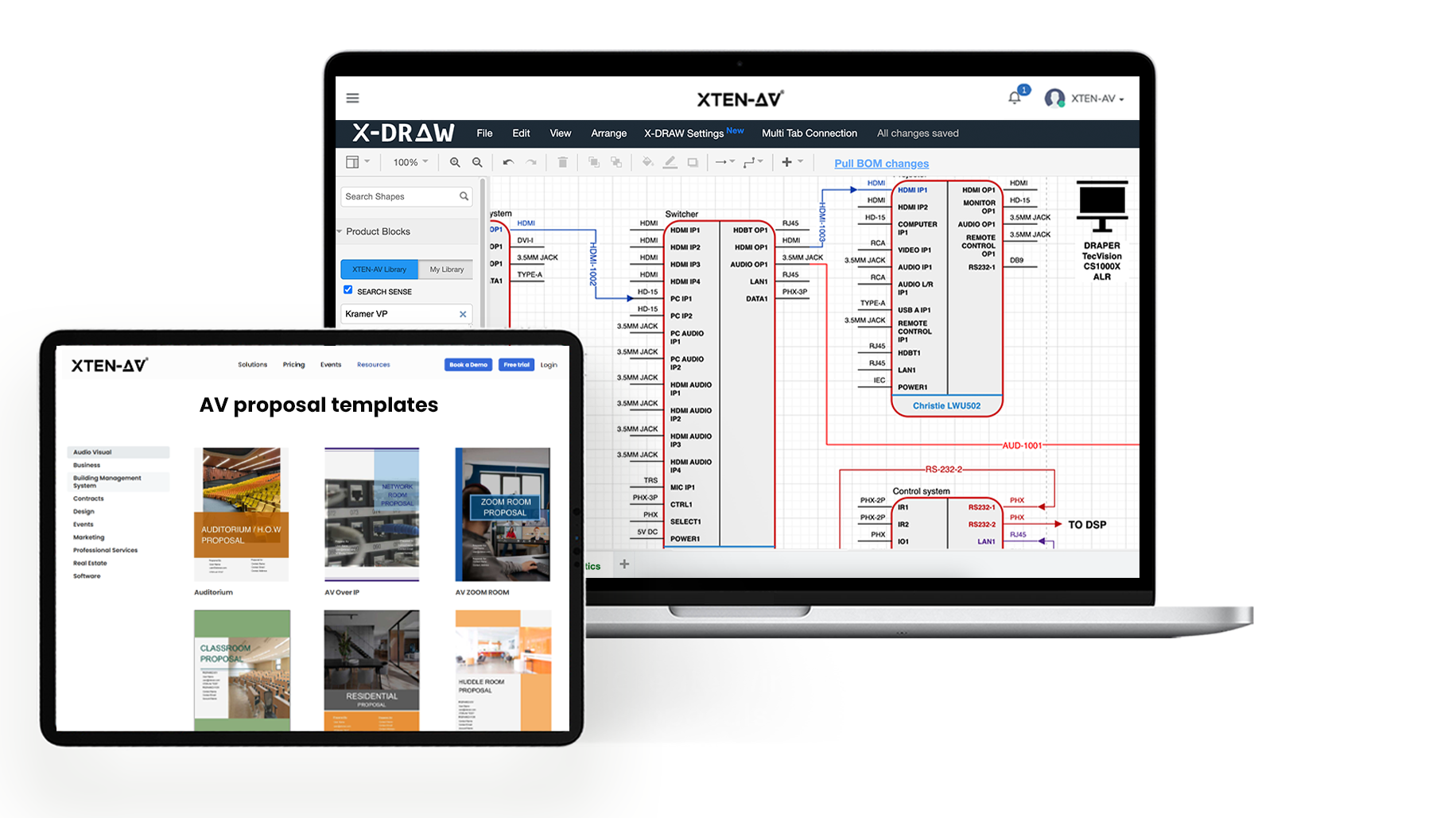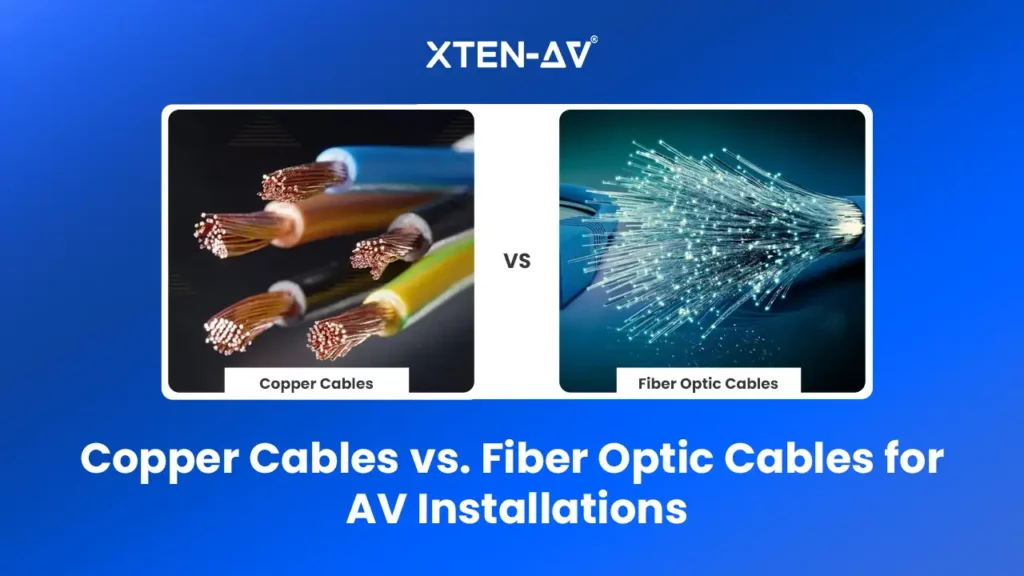Copper Cables vs. Fiber Optic Cables for Future-Proof AV Installations: Which One Should You Choose?
Vibhav Singh
Published 23 Apr 2025
When it comes to AV installation, the correct cable type selection is not just a technical decision but an important factor in determining how well your audio visual system performs. Whether you are setting up a corporate boardroom, a large site, or a high-demonstration control center, the option between copper and fiber optic cables can significantly affect the performance of the AV room system.
Over the years, copper cables have been the industry standard due to their strength and ease of installation. However, since the AV system requires high bandwidth, prolonged transmission distance, and intervention-free signals, fiber optic cables are becoming a more reliable choice. So, what’s the challenge? Choosing the wrong cable type can lead to poor bandwidth, signal degradation over distance, electromagnetic interference (EMI) issues, and expensive troubleshooting under the line.
So, how do you make the right decision? In this blog, we will break down the difference between copper and fiber optic cables, examine their pros and cons, and help you make the best option for your next AV project. Let’s get started.
Key Takeaways:
- Copper cables are cost-effective and work best for short-range AV setups, but they are prone to interference and signal loss over long distances.
- Fiber optic cables provide high-speed bandwidth and long-distance transmission with zero EMI interference, making them ideal for advanced AV-over-IP and high-resolution content delivery.
- XTEN-AV’s X-DRAW streamlines AV integration by automating cable selection, routing, labeling, and schematic creation, ensuring error-free documentation and faster project execution.
The all-in-one solution for your AV needs
Transform your audio-visual experience with XTEN-AV.
No Credit Card required
How Copper AV Cables Work?
Copper wires are widely used in audio-visual cables, providing a reliable way to transmit signals in AV setups. These cables work by carrying electrical signals through a copper wire, causing them to be widely used in everything from theaters of the house to a large-scale networking environment. General types include HDMI, CAT6, SDI, and Analog audio cables; each separate AV meets needs.
And because copper cables are reliant on electrical transmission, they are also subject to electromagnetic interference (EMI) from surrounding equipment, which can negatively impact the internet speed and signal quality. Moreover, these wires experience signal degradation over long distances, often requiring signal boosters or amplifiers to maintain performance. AV cable management methods thus play an important role in maintaining performance and reducing intervention.
Benefits of Copper & Metal Wires
Copper cable has been conventionally employed in AV installation for many reasons, like its durability, affordability in smaller audio-visual spaces, and ease of installation when bandwidth demands are low.
Inexpensive and widely accessible
Compared to optic wire, copper wires are more affordable for customization or guiding AV installers to offer cost-effective installation services with minimal maintenance requirements. They are available and will work with most AV devices without needing special adapters or changes.
Easy installation and maintenance
Copper cables are much easier to mold and install than fiber optics. They don’t need any special tools or technical skills, which makes it one of the go-to solutions for implementing both fast AV installation and AV cable management methods.
Copper Cable Limitations
Even if the copper cables are the most common solution, they do have a couple of disadvantages. They struggle with data transmission speed, and experience signal loss over long distances. Not only this, but EMI issues occur in copper cables because they rely on electric signals to transmit data, and they fail to deliver high-quality signals.
Limited bandwidth
Since copper wires have a limited bandwidth, they struggle to support 4K/8K video and high-speed networking. This limitation can lead to serious issues like delay in signal transmission and signal loss and can reduce the overall performance of the AV setup.
Electromagnetic interference and Signal Loss
Copper cables are affected by electromagnetic interference (EMI) because they can pick up interference from nearby electronic devices, which can disrupt signal transmission. Also, as the length of the wire increases, signal strength weakens due to resistance and signal loss. This is the reason that boosters, amplifiers, or repeaters are needed to maintain signal quality over extended cable runs.
Despite these challenges, copper and fiber optic cables hold their place in AV installation. While copper cables are great for short distances and cost-effective audio-visual cable management solutions, fiber optic wire provides better speed and intervention resistance for high-performance setups. Choosing the right cable depends on the specific requirements of your AV system.
How Fiber Optic AV Cables Work?
No wonder fiber optic wires replace copper cables in AV setups because they offer faster and uninterrupted transmission. Compared to copper cables that transmit data using electrical signals, fiber optic cables use laser or LED-generated light, which is completely immune to electromagnetic interference (EMI) from nearby electronic devices. Apart from this, they maintain signal quality over long distances without disrupting the signals.
Fiber optic cables come in two varieties: single-mode, which allows for far-distance transmission, and multi-mode, which is suitable for short distances and ultra-fast data transfer. Moreover, HDMI and AV-over-IP fibers are mostly optical-based fibers used in AV setups, making streamlining with advanced digital systems possible.
Advantages of Fibre Optic Cables
With fiber optic cables, AV technology has improved a lot as these wires support information to be transmitted at an intervention-free high bandwidth and minimize signal loss. Because of their reliable performance, they are a great fit for commercial and residential AV setups. Here are some benefits:
High bandwidth, fast transmission
These audio-video cables can transmit a lot of data at extremely high speeds, and they’re ideal for high-resolution AV streaming and internet speed optimization for networking. The fiber optic wire ensures minimal signal loss and is capable of transmitting 4K/8K video without any lag, unlike copper wire.
Long-distance signal transmission
Where copper suffers from signal fall, fiber optics hold strong signal integrity over long distances, making them suitable for large-scale AV installations, arenas, stadiums, or conference halls.
No EMI Interference
Since the fiber optic cable transmits signals using light pulses rather than electricity, it is completely immune to EMI interference, resulting in stable and noise-free AV system performance.
Limitations of Fiber Optic Cables
Though they are advantageous, fiber optic cables do pose some challenges. The high advance costs and special install requirements may be barriers for some AV professionals.
High cost
Fiber optic wires are more expensive than copper cables in terms of both purchase and installation. So, AV professionals must carefully identify the total cost of fiber optic cables when preparing the Bill of Materials (BOM). These wires require precision tools like optical power meters and fusion splicers and demand trained professionals for installation, unlike copper wires, which can be easily installed with basic wiring skills. Due to these requirements, the initial cost of installation is higher.
Special installation required
While copper switch plates can be easily installed as they are easy to bend or twist in any shape, fiber optic cables must be handled, maintained, and replaced with precision and expertise using specialized equipment and trained technicians.
Despite the costs, fiber optic cables are the future of AV technology, offering high-speed, reliability, and long-distance EMI performance, making them a top option for high-end AV installation.
When to Use Copper vs. Fiber in AV Installations
The biggest challenge for AV installers or integrators is to recommend the right cable between copper and fiber optic as per their client’s needs. While Copper cables are used for cost-effective, short-range applications, fiber optic cables provide much faster speeds, higher bandwidth, and better resistance to interference for high-performance AV systems. Let’s have a look at the factors to consider when suggesting the wire:
When Copper Cables Are the Right Choice
- Value for Money Solutions – Copper wires are generally cheaper than fiber optic wire, making them great for AV solutions like home theaters, meeting rooms, and small projects with budget constraints.
- Short-Distance Transmission – Copper is excellent for under 100-meter cable runs, which makes it suitable for standard HDMI, SDI, and analog audio connections in small spaces.
- Basic AV Applications – In applications where there are no high bandwidth demands, for instance, analog audio systems or standard HDMI installations, copper cables are a convenient and broad partner solution.
When Fiber Optic Cables Are the Better Option
- High-Resolution AV & Data-Intensive Applications – Fiber optic cables are well-suited for high-resolution video (like 8K), high-quality audio, and fast networking because they can handle large amounts of data efficiently. This makes fiber wires ideal for AV-over-IP setups, where audio and video are transmitted over networks instead of traditional AV cabling.
- Interference-Free Connectivity – These cables do not suffer from electromagnetic interference (EMI) because they transmit data using light instead of electrical signals. This makes them ideal for AV installations in environments with high electrical interference, such as factories, areas near power lines, or places with heavy electronic equipment.
- Long-Distance Signal Transmission – They can carry data over long distances without weakening the signal. Fiber optic wires keep the signal strong and clear without degradation, making them ideal for large-scale AV setups, such as concert venues, university campuses, office buildings, and stadiums where long-distance cabling is required.
Ultimately, the decision between copper and fiber optic cables depends on the specific demands of the installation. Copper remains a cost-effective and practical choice for shorter distances and lower-bandwidth applications, while fiber optics provide unmatched reliability, bandwidth, and long-range performance for modern AV systems.
Is Fiber Optic Cable Worth the Extra Cost?
At first glance, fiber optic cables may seem more expensive than copper cables due to their higher material costs, specialized installation requirements, and the need for advanced tools like splicers and cleavers. However, when evaluating prolonged performance, durability, and maintenance, fiber often proves to be a more cost-effective option over time.
Take the example of a large corporate office network or stadium AV system. Many enterprises initially used copper cables for their networking and AV needs. However, as data demands increased, they faced continuous maintenance, signal fall, and intervention issues. Infection in fiber optic cable eliminated these problems, decreasing downtime and operating costs.
If AV experts suggest using fiber optics at the beginning of an installation instead of copper cables, their clients can save up to 40% on long-term expenses.
Yes, the initial installation of fiber optics is expensive, but over time, they are most cost-effective because they have a longer lifespan, require less maintenance, and provide better performance, making them a perfect fit for AV systems that need to remain efficient in the future.
Additionally, fiber’s ability to support high-speed networking and AV-over-IP meant that businesses could handle future bandwidth demands without expensive upgrades.
For example, stadiums and large event venues that stream 8K video feeds on several screens require a comfortable, high-bandwidth transmission. Using copper wires means adding the rippers and signal boosters, increasing the cost and complexity. In contrast, fiber optic cables transmit data at long distances without loss, making them better long-term investments.
The all-in-one solution for your AV needs
Transform your audio-visual experience with XTEN-AV.
No Credit Card required
How XTEN-AV Helps AV Integrators Choose the Right Audio Visual Cables?
Suggesting the right audio-visual cables is a key challenge in every AV integration, and it often increases the chances of signal degradation, EMI interference, and re-investment during upgradation. The X-Draw tool of XTEN-AV solves these problems with a range of features:
- Correct Cable Selection – XTEN-AV provides guidance and tools like X-Draw to AV professionals like AV integrators, installers, or designers to select the right cable between copper and fiber optic. Different AV setups require different amounts of data transmission; XTEN-AV ensures that the cables can handle the required bandwidth. Factors like cable length, environmental conditions, and routing complexity are considered to ensure the best cable choice based on the project requirements of the client.
- Automated Wiring Diagrams & BOMs – The platform creates an automated wiring diagram that showcases how all cables should be connected in an AV system, eliminating the need for manual diagramming. These diagrams serve as a blueprint to help AV professionals correctly wire their setups. Not only this, but it also provides a BOM that contains a detailed list of all necessary cables, connectors, and components needed for the project. By automating this process, AV professionals can save time, avoid errors, and speed up their workflow instead of manually listing and mapping out cables.
- Error-Free Cable Labeling & Routing – It ensures that each cable is labeled and routed properly within a project so that AV professionals can easily identify its purpose and connection and avoid tangles, misplacement, signal interference, or incorrect connections. Clear labeling and routing make it easier for installers and technicians to understand the wiring system. In this case, if an issue arises, AV professionals can quickly identify and fix the problem without wasting time searching for the right cables.
By harnessing these capabilities, AV integrators can improve their efficiency and accuracy both in selecting and documenting cables, contributing to more successful projects overall.
AV Design Mastery + Winning Proposals = 10x Productivity!
- ✔ Automatic Cable Labeling & Styling
- ✔100+ Free Proposal Templates
- ✔ Upload & Create Floor Plans
- ✔1.5M Products from 5200 Brands
- ✔ AI-powered ‘Search Sense'
- ✔Legally Binding Digital Signatures

Conclusion
When selecting the right cabling for AV installations, two options arise: copper vs fiber optic cables. While copper cables are a cheaper option for low bandwidth over short distances, the growing trend in high-speed, long-distance AV transmission is fiber optic wire.
XTEN-AV’s X-DRAW simplifies cable selection and documentation by automating wiring diagrams, BOMs, and cable labeling, ensuring accuracy and efficiency in AV projects. By leveraging advanced AV design tools, integrators can streamline workflows, reduce errors, and optimize installations.
FAQ's
Copper wires are mainly used for internet communication because they are able to transmit electrical signals effectively. Copper short-destination data was the best option for data transmission in the early days of the Internet when the speed and bandwidth required had not yet set a high demand. However, fiber optic cable became the alternative due to its high capacity and long-distance capabilities as technology improved.
No, pure fiber optic cables are fully made of glass or plastic fibers and transmit data using light instead of lightning. However, some hybrid cables combine fiber and copper elements to provide electricity to some devices or provide backup connectivity. They are used in special applications where both power and high-speed data transmission are required.
It is true that fiber optic cable comes with added expense as it requires specialized materials and an installation process. But they have longer lifespans, need less maintenance, and perform significantly better throughout that lifespan. Including the total cost of ownership, fiber is also often more cost-effective than copper-based solutions because of efficiency and reliability, as well as very low operating expenses.
Fiber optic cables are ideal for connecting buildings as they provide immunity to high bandwidth, fast speed, and electromagnetic interference (EMI). Copper cables indicate a decline and intervention, especially in the high-power environment. The fiber maintains long distances continuously and has high-quality transmission, making it the best option for complexes, commercial parks, and multi-billing AV setups.
Copper cables experience signal loss and reduced speeds over longer distances due to electrical resistance. Beyond 100 meters, they require boosters or repeaters to maintain performance. Fiber optic cables, on the other hand, can transmit data over tens of kilometers without significant speed reduction, making them the superior option for large-scale AV and networking installations.
For short distances, high-performance copper cables such as CAT 6A and CAT 8 can support Gigabit and even 10 GBPS speeds. However, fiber optics crosses copper in both distances speed and reliability, making it 8K video streaming, over-IP, and large-scale networking such as high-bandwidth applications such as networking.
The right choice depends on the application. Copper cables are more affordable and effective for short-range audio/video and networking applications but are prone to interference and speed degradation over long distances. In some cases, fiber optic cables, which initially cost more but offer higher speed and bandwidth as well as long-term reliability, are perfect for enterprise networks, stadiums, and future-proof AV installations.
Explore more by topic
AV Design Mastery + Winning Proposals = 10x Productivity!
- Automatic Cable Labeling & Styling
- 100+ Free Proposal Templates
- Upload & Create Floor Plans
- 1.5M Products from 5200 Brands
- AI-powered ‘Search Sense'
- Legally Binding Digital Signatures
No Credit Card Required
Related Blogs

-
- Posted by Sahil Dhingra
Audio Visual Security Site Survey for System Design & Integration Checklist Sahil...

-
- Posted by Sahil Dhingra
Audio Visual How to Mount a Projector Without Guesswork Vibhav Singh Published...

-
- Posted by Sahil Dhingra
XTEN-AV Black Friday and Cyber Monday Deals in 2025 For Audio Visual...



